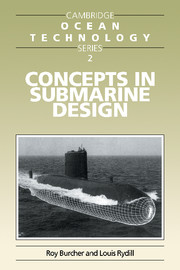Book contents
- Frontmatter
- Contents
- Introduction
- Acknowledgements
- 1 Design in general
- 2 Milestones in submarine history
- 3 Submarine hydrostatics
- 4 The weight/space relationship
- 5 Submarine structures
- 6 Powering of submarines
- 7 Geometric form and arrangements
- 8 Dynamics and control
- 9 Submarine systems
- 10 Considerations of building and costs in design
- 11 Generating a concept design
- Appendix 1 Hydrostatic conditions of flotation
- Appendix 2 Operational practice for keeping in trim
- Appendix 3 Assessing weight and size of variable ballast
- Appendix 4 Submarine pressure hull strength (Prediction of interframe collapse pressures)
- Appendix 5 Estimates of resistance and propulsion
- References and suggested reading
- Index
Appendix 3 - Assessing weight and size of variable ballast
Published online by Cambridge University Press: 05 July 2014
- Frontmatter
- Contents
- Introduction
- Acknowledgements
- 1 Design in general
- 2 Milestones in submarine history
- 3 Submarine hydrostatics
- 4 The weight/space relationship
- 5 Submarine structures
- 6 Powering of submarines
- 7 Geometric form and arrangements
- 8 Dynamics and control
- 9 Submarine systems
- 10 Considerations of building and costs in design
- 11 Generating a concept design
- Appendix 1 Hydrostatic conditions of flotation
- Appendix 2 Operational practice for keeping in trim
- Appendix 3 Assessing weight and size of variable ballast
- Appendix 4 Submarine pressure hull strength (Prediction of interframe collapse pressures)
- Appendix 5 Estimates of resistance and propulsion
- References and suggested reading
- Index
Summary
In design, when the trim and compensation arrangements are being addressed, a procedure is required for sizing the tanks and assessing the amount of water in them, i.e. the weight of variable ballast. The method we now describe, which is widely used for the purpose, is to be read in conjunction with Figure A3.1.
(a) A standard condition of the submarine is defined, i.e. one with full crew, stores and fuel on board, with the boat in water of standard density 1.0275. A statement is drawn up of all the weights and locations of items which might vary during the course of a patrol, including buoyancy changes, especially those associated with extremes, e.g. maximum changes of seawater density between say 1.00 and 1.03 (or whatever is appropriate for the submarine under design).
(b) A graph is prepared with a horizontal axis for longitudinal moments and a vertical axis for forces, the origin representing the standard condition of the boat. The weight and buoyancy changes in the statement from (a) are plotted as a series of discrete points on the graph to the convention that reductions in weight forward are placed in the first quadrant. The aim is to cater for demanding combinations of weight and buoyancy changes which are sensible but nevertheless still serve to establish the boundary of extreme conditions in which the boat might find itself. Thus towards the end of a patrol a submarine, having consumed nearly all of its stores and fuel, might have to enter an area in which sea-water density is high; alternatively a submarine shortly after leaving base to go on patrol might have to enter water which is almost fresh. […]
Information
- Type
- Chapter
- Information
- Concepts in Submarine Design , pp. 282 - 285Publisher: Cambridge University PressPrint publication year: 1994
